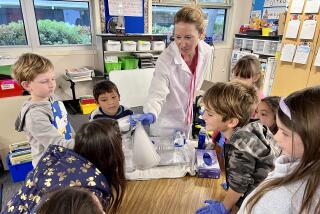An Interactive Field Trip Via Technology
ANAHEIM â Although they were hundreds of miles apart, students from Santa Ana, Central California and Oregon participated Wednesday in their first interactive class--technology that some educators believe could revolutionize how students are taught.
While sophomores from Century High School in Santa Ana demonstrated the technology by discussing earthquakes from the SUPERCOMM exhibit at the Anaheim Convention Center, students from Oakhurst, Calif., and Tigard, Ore., talked from their schools about forest fires and volcanoes.
Students from Fresno, Mendocino and San Bernardino counties, along with an instructor from Los Angeles Harbor College, also were hooked up to the system. They listened in and asked questions but didnât make presentations.
Throughout the lesson on natural disasters, students watched each other on video monitors and asked direct questions through an integrated digital network that is being introduced at schools throughout the country.
âStudents will no longer be confined by four walls,â said Gary Wheaton, assistant principal at Century High, which is the only Orange County school hooked up to the network.
âThey now can learn from others all over the world,â he said. âHow often would these kids in Santa Ana be face-to-face with kids in Oregon? The answer before was ânever.â But now they can do it every day.â
As sophomore Sandra Mosqueda of Century High talked about how her father ran outside in his underwear after the 1994 Northridge earthquake, students from Oregon and throughout California listened and laughed.
A student also was able to ask Gail Montwill, a science instructor at Harbor College, if itâs true that half of California could drown in the ocean during the âbigâ earthquake thatâs expected to hit the area someday.
âItâs not going to drop half of us in the sea,â Montwill responded from a classroom at the college. âWe canât predict when or if an earthquake is coming. But we can prepare for it.â
*
Although Century High installed its interactive equipment in January, Wednesday was the first time when students got to test the system. The network essentially relies on a computer attached to a video camera that allows sound, images, video and data to be transmitted simultaneously.
âWith this, you get an idea of how things are in other parts of the world,â Mosqueda said after the demonstration. âItâs more interesting than looking at books.â
Although schools throughout the country already are using the technology, Pacific Bell recently installed the communication device at 11 schools in its service area, including Century High.
Because these schools agreed to serve as demonstration sites, Pacific Bell and other corporations waived costs of the equipment and software.
As part of a statewide âEducation Firstâ initiative to accelerate education technology in California, Pacific Bell has agreed to install the communication services at any school in its service area at no cost for a year.
Schools, however, must purchase their own software and hardware, which can cost at least $6,000.
âI can see using this to have students talk to political leaders, scientists and astronauts in space,â said Alan Gersten, a science and technology teacher at Century High who led the demonstration. âRight now, we donât even ask people to come because we have to pay for their air fare and accommodations.â
Gersten said he also can see videotaping a field trip and then sharing the images with students at other schools.
âWeâll be able to write things on the computer and share it with other students,â he said. âThis technology could break down stereotypes. For instance, a lot of people think students in California are blond-haired and blue-eyed. Theyâre not expecting to see a class of Latino students like we have in Santa Ana.â
More to Read
Sign up for Essential California
The most important California stories and recommendations in your inbox every morning.
You may occasionally receive promotional content from the Los Angeles Times.










